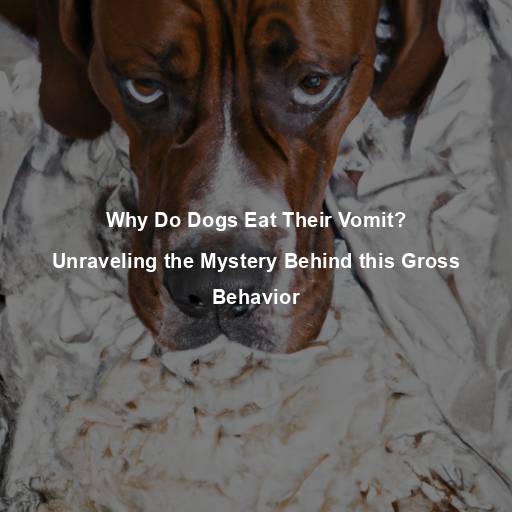When Dogs Cry in Their Sleep: Unraveling the Mystery Behind Canine Dreams
Last Updated on October 22, 2023 by Evan
Contents
- 1 The Enigmatic World of Canine Sleep
- 1.1 Understanding Canine Dreams
- 1.2 The Purpose of Canine Dreams
- 1.3 Decoding Canine Dream Content
- 1.4 The Emotional Rollercoaster of Canine Dreams
- 1.5 The Role of Memory and Trauma
- 1.6 Empathy and Sensitivity: Unveiling the Tears
- 1.7 Physical Discomfort and Medical Conditions
- 1.8 The Power of Love and Reassurance
- 2 A Window into the Canine Soul
- 3 Interpreting Canine Dream Behavior
- 4 Supporting Our Canine Dreamers
- 5 The Profound World of Canine Dreams
- 6 FAQs – When Dogs Cry in Their Sleep
The Enigmatic World of Canine Sleep
Throughout history, dogs have captivated our hearts with their enigmatic ability to wander through realms unknown. As we peer into the ethereal realm of their slumber, the spectacle of their twitching paws and muffled barks leaves us transfixed. A question lingers in the air like a floating wisp of curiosity – do these enigmatic beings dream as we do? And what whispers of sorrow or joy stir within them, causing tears to fall from their dreaming eyes?
Understanding Canine Dreams
Ever wondered what goes on inside your pooch’s mind while they sleep? While direct communication may not be an option, scientists have delved deep into the science of canine sleep to shed some light on this intriguing subject. Turns out, our furry friends experience sleep cycles akin to humans, complete with the fascinating realm of dreams during the REM phase. Remarkably, their brainwave patterns during this stage bear a striking resemblance to ours, implying that dogs may have dream adventures just like us.
The Purpose of Canine Dreams
Dreams serve a vital function in the lives of both humans and dogs. They are believed to play a role in memory consolidation, emotional processing, and learning. For dogs, dreams may be particularly crucial for their development and overall well-being. Just like puppies engage in play to refine their motor skills, dreams could be a form of mental play that aids in cognitive development, socialization, and problem-solving.
Decoding Canine Dream Content
While we can’t know the precise content of our furry friends’ dreams, researchers have made educated guesses based on their behavior during sleep. Dogs often exhibit movements and vocalizations that mirror their waking experiences. It’s not uncommon to see a dog’s legs twitching as if running or hear them emit soft barks, whimpers, or cries. These behaviors strongly suggest that dogs are reliving their daily activities, encounters, and emotions during their dreams.
The Emotional Rollercoaster of Canine Dreams
Emotions are an integral part of both human and animal dreams, and dogs are no exception. Their dreams can evoke a range of emotions, including joy, excitement, fear, and even sadness. It is this last emotion – sadness – that prompts our curiosity about why dogs cry in their sleep. To understand this phenomenon, we must consider various factors that may contribute to their emotional distress during dreams.
The Role of Memory and Trauma
Just like us, our canine companions can carry the weight of emotional baggage from their past. The haunting echoes of abuse or abandonment can etch deep scars on their souls. When they drift off to sleep, the invisible shackles of their traumatic memories may come alive, sending waves of fear and sorrow through their dreams. It’s almost as if these four-legged beings find solace in the tears shed during their slumber, a cryptic release of the emotions they once held captive within.
Empathy and Sensitivity: Unveiling the Tears
Dogs are known for their remarkable empathy and sensitivity towards their human companions. They can sense our emotions and often mirror them, forming a deep emotional bond with us. When dogs cry in their sleep, it could be a manifestation of this empathy, as they absorb and process our emotions, even in their dreams. Their tears may symbolize their connection with us, expressing the sadness they perceive in our own lives.
Physical Discomfort and Medical Conditions
While emotional factors play a significant role in dogs crying during sleep, it’s crucial not to overlook potential physical discomfort or underlying medical conditions. Dogs experiencing pain, such as arthritis or gastrointestinal issues, may cry out in their dreams as their subconscious brings these sensations to the forefront. In such cases, seeking veterinary care is crucial to address their discomfort and ensure their well-being.
The Power of Love and Reassurance
Witnessing our beloved companions cry in their sleep can be distressing. However, it’s essential to respond with love and reassurance rather than undue worry. Dogs, like humans, may have occasional unsettling dreams, but their resilience and capacity for joy far outweigh these moments of sadness. Providing a safe and nurturing environment, ample exercise, mental stimulation, and affectionate companionship can help alleviate any underlying stress and foster a sense of security.
A Window into the Canine Soul
The mystery behind why dogs cry in their sleep may never be fully unraveled. But what we do know is that their dreams offer us a glimpse into their rich inner lives. Just as we experience a range of emotions in our dreams, our canine companions embark on their own emotional journeys, processing their daily experiences and connecting with us on a profound level. So, the next time you see your furry friend crying in their sleep, remember that it is a testament to their complex emotional world and the bond you share.
Unveiling the Canine Dream Realm
The enigmatic world of canine dreams continues to bewilder and captivate researchers and dog lovers alike. Through the ingenious application of cutting-edge technologies, such as electroencephalography (EEG) and functional magnetic resonance imaging (fMRI), scientists have managed to peek into the cryptic realm of canine slumber. These remarkable discoveries not only unveil the inner workings and mysterious neural processes of their dreamscapes but also offer profound insights into the emotional and cognitive dimensions that shape their nocturnal adventures. As we unlock the secrets behind their reveries, the enigma deepens, leaving us in awe of the complex inner lives our furry companions lead while they succumb to the realm of dreams.
Brain Activity during Canine Dreams
It’s mind-boggling to think that dogs and humans share a common neurological pattern during REM sleep, the magical window where dreams come to life. Recent research has unveiled a fascinating revelation: dogs exhibit heightened brain activity in the hippocampus, the very haven of memories and emotions. These findings unveil a perplexing possibility, hinting at the intricate tapestry of canine dreams, where cherished moments and heartfelt experiences intertwine. As if delving into the depths of their inner world, the activation of the amygdala, known for its role in emotional processing, adds another layer to the mesmerizing enigma of our furry friends’ dreamscapes.
Dream Replays: The Role of Memory
Memory plays a pivotal role in shaping dreams, both in humans and dogs. When dogs enter the REM phase, their brain activity patterns resemble those observed when they actively engage with their surroundings. This suggests that their dreams may involve the replaying of past events, allowing them to consolidate memories, reinforce learning, and possibly even anticipate future scenarios. It is through this process of memory consolidation that dogs assimilate and make sense of their waking experiences.
Emotional Processing in Canine Dreams
When it comes to dreams, it’s not just us humans who get swept away in a whirlwind of emotions. Our loyal companions, the dogs, are no strangers to the rollercoaster ride of feelings that play out in their slumber. Whether it’s the tail wagging in delight, the adorable whimpering, or even the heart-rending crying, dogs seem to be wearing their emotions on their sleeves while they dream. Just like us, their dreams encompass a mosaic of sentiments – from sheer happiness and intense fear, to boundless excitement, and yes, even a touch of melancholy.
Interpreting Canine Dream Behavior
Unraveling the Meaning of Crying in Dreams
When the gentle slumber embraces our beloved canine companions, they occasionally experience moments of emotional turbulence that manifest with soft weeping. However, it is crucial to explore the intricacies surrounding these tearful episodes, as the context and myriad factors involved unravel the intricate tapestry of their dream-like reverie. Delving deeper into this enigmatic phenomenon reveals a captivating spectrum of potential causes, not solely limited to sorrow, as our canine counterparts, much like us, may shed tears for a plethora of reasons tethered to their rich tapestry of experiences and sensibilities.
Unresolved Emotional Trauma
Dogs, like humans, can carry emotional baggage from past traumas. If a dog has experienced abuse, neglect, or other distressing events, their dreams may serve as a means of processing unresolved emotions. Crying during these dreams may signify their attempt to confront and cope with the lingering effects of their past experiences. Providing a safe and loving environment is crucial to helping them heal and move forward.
Empathic Response to Human Emotions
It’s both bewildering and awe-inspiring how dogs possess this mysterious power to deeply resonate with our emotions. They effortlessly tap into our emotional frequency, almost like tuning into a heartwarming symphony of empathy. So, when they shed a tear during slumber, it’s an intricate dance of complexities. Perhaps, just perhaps, these canine companions are mentally navigating the emotional landscapes of their human pack, showering us with their unspoken support and compassion.
Physiological Discomfort or Distress
When it comes to tears in our dreamscapes, our emotions usually take center stage. However, it would be remiss to disregard the possibility of physical discomfort or health ailments playing a role in this nightly spectacle. Our furry companions, dogs, are not exempt from this enigmatic phenomenon either. It has been observed that dogs may emit cries while in slumber due to various physical discomforts like gastrointestinal woes or joint inflammation.
Dreams as Emotional Outlets
The essence of dreams lies in their ability to unravel the tangled emotions that dogs harbor within. Much like how humans find solace in shedding tears or erupting into laughter through the veil of dreams, our furry friends may manifest their emotions by crying. It is crucial for us to approach these moments with empathy, offering our unwavering support and a comforting presence to our beloved canines.
Supporting Our Canine Dreamers
Creating a Calming Sleep Environment
As dog owners, we all want our furry friends to have a blissfully tranquil slumber. So, how can we create the optimal doggy sleep haven? Well, it all starts with the perfect bed, a serene and hushed sanctuary, and a predictable nightly routine. By minimizing distractions and cultivating an atmosphere of tranquility, we can enhance the overall sleep experience for our beloved four-legged snoozers.
Promoting Emotional Well-being
Ensuring the emotional well-being of our furry friends is of utmost importance – both in their wide-awake moments and even in their slumber. Just like us humans, dogs too need their fair share of exercise, mental challenges, and social interactions to maintain a balanced state of happiness. By incorporating activities that ignite positive vibes – think playful adventures, insightful training sessions, and heart-to-heart connections – we can help alleviate their worries and ensure their dreams are as blissful as can be.
Consulting with Veterinary Professionals
If you notice that your pooch’s dream antics, such as whimpering, seem a bit out of control or if there are any other worrisome signs alongside, it’s always a smart move to tap into the expertise of a seasoned veterinarian. These talented individuals can dive deep into a comprehensive evaluation, meticulously decode any hidden health issues, and steer you in the right direction. When it comes to safeguarding the welfare of our four-legged companions, there’s no one better equipped to handle the medical nitty-gritty than our veterinary heroes.
The Profound World of Canine Dreams
Delving into the enigmatic realm of canine slumber, we find ourselves on a perpetual expedition to understand the origin of their tearful expressions during the night. With every revelation, we glimpse fragments of their complex emotional landscape, offering a tantalizing glimpse into the depths of their inner thoughts. Though the mysteries of their dreams may forever evade our complete grasp, let us tread this path with unwavering empathy, seeking to shower our beloved canines with the affection and nurture they so rightfully deserve. As we bask in the extraordinary kinship between humans and our endearing furry counterparts, let us revel in their captivating dreamscapes and the profound bond that unites both species.
FAQs – When Dogs Cry in Their Sleep
What does it mean when dogs cry in their sleep?
When dogs cry or make sounds while sleeping, it commonly indicates that they are experiencing a dream or a vivid sleep state. Just like humans, dogs can have dreams that evoke different emotions, including happiness, fear, or sadness. Crying during sleep might be a reflexive response to the content of their dream, similar to how humans may talk or move during their dreams. However, it’s important to note that dogs can also make sounds during sleep that we perceive as crying, even if they are not actually experiencing any distress.
Is it normal for dogs to cry or whimper in their sleep?
It’s perfectly natural for our furry friends to let out a few yips and whimpers while catching some Z’s. Dogs, like us, experience vivid dreams and their sleep sounds are often a reflection of their dream-filled adventures. In most cases, these sleepy vocalizations are harmless and nothing to fret over. However, if your canine companion’s cries become increasingly intense, take on an unfamiliar tone, or are accompanied by concerning physical signs such as trembling or seizures, it may be best to seek the guidance of a trusted veterinarian to ensure there are no underlying health concerns at play. Rest assured, our pets’ dreamland escapades can sometimes leave us scratching our heads in puzzlement.
Can dogs have nightmares or bad dreams?
Yes, dogs can have nightmares or bad dreams. While it can be challenging to determine the exact content of a dog’s dream, research suggests that dogs experience similar sleep stages as humans, including Rapid Eye Movement (REM) sleep associated with dreaming. Just like humans, dogs can potentially encounter unpleasant experiences, triggering negative emotions during their sleep. If you notice your dog consistently crying, growling, or displaying signs of distress during sleep, it may be an indication that they are having a bad dream. Providing comfort and reassurance can help alleviate their anxiety upon waking.
Should I wake up my dog if they are crying in their sleep?
When it comes to dogs and their mysterious slumbers, a question that often perplexes pet owners is whether or not to disturb them when they are crying. Unlike humans, our furry friends require undisrupted sleep for their intricate sleeping cycles, which play a vital role in maintaining their overall health and wellness. Theories about this topic vary like whispers in the wind: some argue that waking them up might startle and stress them, while others suggest gently rousing them if their cries seem excessive or accompanied by physical distress. In these puzzling situations, seeking the guidance of a trusted veterinarian could provide the clarity needed to ensure the well-being of our beloved canine companions.
What can I do to help my dog if they frequently cry during sleep?
Does your beloved furry friend often shed tears in their sleep, leaving you perplexed and worried? Fret not, for there are steps you can take to ease their slumber-time woes. Start by ensuring that your dog receives ample physical and mental stimulation throughout the day to promote restful sleep. Create a serene and plush sleeping space, complete with a cozy bed or a designated sleep area, so they can snuggle up in comfort. Furthermore, consider incorporating gentle sounds, like soft background music or the rhythmic ticking of a clock, to lull them into a peaceful sleep. Should the crying persist or intensify, it may be wise to seek out the expert opinion of a qualified veterinarian for a comprehensive assessment and appropriate guidance.






